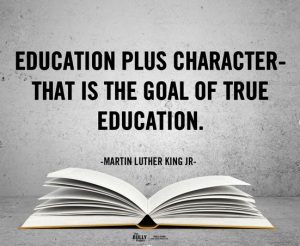What is character education? Character education is “the intentional effort to develop in young people core ethical and performance values that are widely affirmed across all cultures.” (Licona, 2014). But what does character education look like in the 21st century? This is the driving question that needs to be answered today.
Students today are more digitally connected to their peers than ever before. Learning is no longer just what happened in the classroom during the day with instruction from a teacher. Students are constantly learning from all sorts of stimulation around them and it carries on long after the school day primarily through social media. Students today are both consumers and producers of this content.
Researchers are beginning to notice a trend that students today have 2 lives, one in school and one online. The in-school presence is one of following the rules and using kind words. In the online world, behind the safety of a keyboard, it’s cool to be cruel (Steiner-Adair, 2015).
Technology has changed the way we live and relate in the world. Students are often the first to embrace these new forms of technology but sadly lack the maturity to use it in a healthy way. “Youth currently spend an average of 8.33 hours per day – more hours than a full-time working adult – engaging with technology-driven media” (Rideout, Roberts, & Foehr, 2005). Character Education and social-emotional learning must not only be taking place in the schools, but also reaching into the after school life of students as well.
As you can see, the need is evident. Educators today we are presented with a challenge, but also a great opportunity. The challenge is how to develop the social and emotional skills in our students to make them successful in their real lives as well as their digital ones. Teaching our students to be responsible global citizens and teaching them to create positive content for their social media worlds.
Teachers and school leaders have a unique opportunity to shape the social-emotional development of our students today. As we look at our world today it is easy to become discouraged. The messages we hear on a daily basis can be divisive, untrue, and unkind. Mass shootings are sadly becoming part of the American narrative. This is the world in which our students are being brought up. Providing the necessary tools for filtering through these stories , while at the same time developing emotionally intelligent young people to insert positive messages to the conversation.
President Theodore Roosevelt said, To educate someone in mind and not in morals is to educate a menace to society.” I believe that if we succeed in teaching our core curriculum to our students but they lack in social, emotional, and character components we have failed that generation and it will not be without consequences. It is our duty to teach the whole child and convey that message in a way that is timely and relevant.
I come back to my original question, “What does character education look like in the 21st century?” Well, it looks a lot like it always has looked. The message has not changed, just the methods for delivering it. In order to reach students, you must meet them where they are.
References:
Lickona, T. (2014). A Framework for School Success: Eleven Principles of Effective Character Education, 1–28.
Roberts, D.F, Foehr, U.G., & Rideout, V. (2005, March).Generation M: Media in the lives of 8-18 year-olds. A Kaiser Family Foundation Study.
Steiner-Adair, C. (2015). The big disconnect: Your student in class vs. your student online.Independent School, 74(2).

Mr. Panella, I enjoyed reading your article and agree with your position on not changing the message of character education, but changing the vehicle for delivery. It is alarming how early children are going “Digital” and like your article articulates, the faculties to make effective choices are not developed in these students.